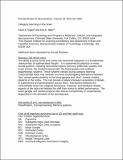Category Learning in the Brain
Author(s)
Miller, Earl K.; Seger, Carol A.
DownloadSeger and Miller - Final Manuscript.pdf (276.5Kb)
OPEN_ACCESS_POLICY
Open Access Policy
Creative Commons Attribution-Noncommercial-Share Alike
Terms of use
Metadata
Show full item recordAbstract
The ability to group items and events into functional categories is a fundamental characteristic of sophisticated thought. It is subserved by plasticity in many neural systems, including neocortical regions (sensory, prefrontal, parietal, and motor cortex), the medial temporal lobe, the basal ganglia, and midbrain dopaminergic systems. These systems interact during category learning. Corticostriatal loops may mediate recursive, bootstrapping interactions between fast reward-gated plasticity in the basal ganglia and slow reward-shaded plasticity in the cortex. This can provide a balance between acquisition of details of experiences and generalization across them. Interactions between the corticostriatal loops can integrate perceptual, response, and feedback-related aspects of the task and mediate the shift from novice to skilled performance. The basal ganglia and medial temporal lobe interact competitively or cooperatively, depending on the demands of the learning task.
Date issued
2010-07Department
Massachusetts Institute of Technology. Department of Brain and Cognitive Sciences; Picower Institute for Learning and MemoryJournal
Annual Reviews in Neuroscience
Publisher
Annual Reviews
Citation
Seger, Carol A., and Earl K. Miller. “Category Learning in the Brain.” Annual Review of Neuroscience 33.1 (2010): 203–219.
Version: Author's final manuscript
ISSN
0147-006X
0147-006X